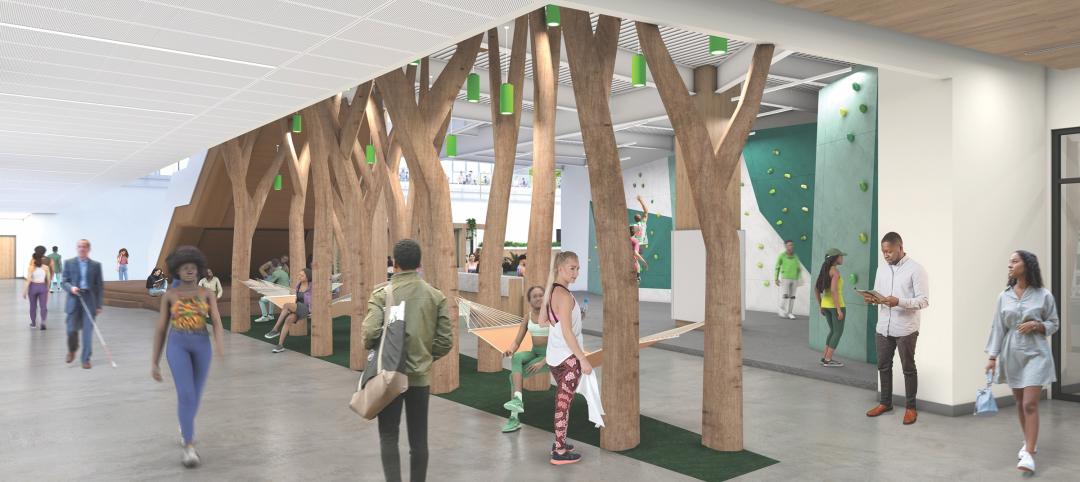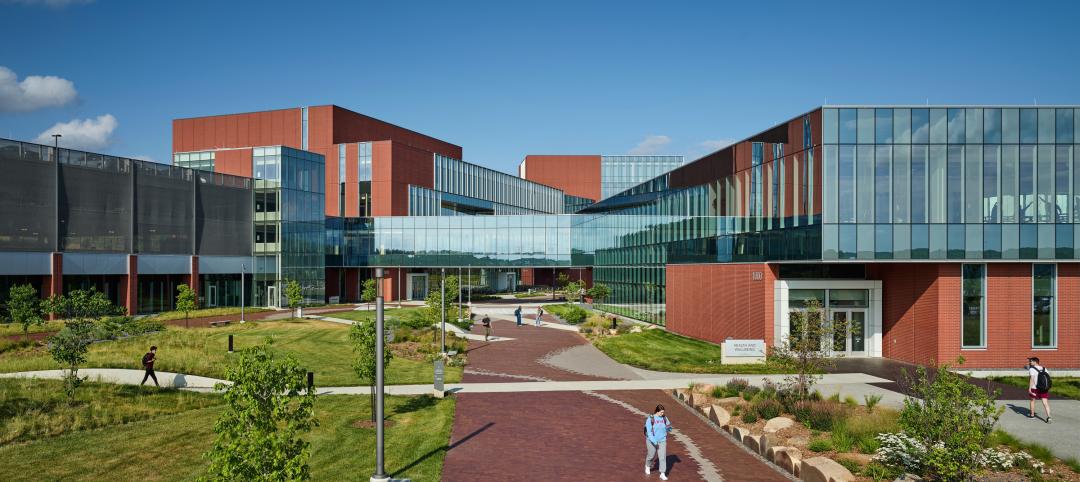In February, we opened our 2012 series on design and construction trends in university buildings with a report on “fusion facilities”. We continue the discussion with four more trends that are shaping collegiate projects:
- New concepts of classroom design
- Increasing use of flexible space concepts
- More common areas for collaboration
- Repurposing of library space
Behind these trends are several dramatic forces that are cutting right to the heart of the university’s mission:
- The growing use of project-based teaching
- The pressure to hold costs down as rising tuition and fees outpace inflation
- A movement to promote cross-disciplinary collaboration
- New technologies that are changing pedagogy and how students and faculty interact
1. NEW TAKE ON THE COLLEGE CLASSROOM
Current pedagogical methods at the college level emphasize problem-based learning and collaboration among students over the traditional lecture format. “Experiential learning is at the forefront of just about every discipline,” says Jeff Ziebarth, AIA, LEED AP, a principal in the Minneapolis office of Perkins+Will. “Students are becoming the instructors, and instructors are becoming facilitators.” Working on group projects is believed to promote better retention of knowledge than the traditional lecture model, researchers are finding. So, classrooms must change to meet these new demands.
The Technology Enabled Active Learning (TEAL) classroom in MIT’s Stata Center for Computer, Information and Intelligence Sciences contains 13 round tables, with seating for nine students per table, and three laptop computers per table to accommodate teams of three students. Instructors sit at a workstation in the center of the room. A typical class includes hands-on experimentation supported by interactive digital media.
New and renovated classrooms at many institutions include easily movable furniture and media-rich presentation technology. Missing from this picture: a front-of-the-room podium, says Brad Lukanic, AIA, LEED AP, a principal with Cannon Design, New York. “Every surface of the room has media on it,” he says. “There could be projectors on all four walls.” Packed with electronics, these rooms may require an upgraded electrical system on rehabs of older buildings.
Students can project their work onto a single screen for their own group or onto multiple screens for the whole class to view. “This design takes more square footage than the traditional classroom,” 25-40 sf/person for multimedia, vs. 17-18 sf/person for traditional, Lukanic notes. That makes it more critical for administrators to maximize the utilization rates of updated classrooms. In many cases, multiple departments must share these spaces, which goes against the grain of many institutions that are accustomed to having dedicated buildings for each discipline.
[pagebreak]
2. FLEXIBILITY: THE KEY TO NEW DESIGNS
At Duke University, Durham, N.C., the Link Teaching and Learning Center—a prototype area for testing new teaching methods—is a new space shared by many departments. Housed in the ground floor of the university’s central library, the technology-rich space is highly flexible to accommodate classes and study groups of varying sizes. A test bed for new classroom design, Duke has undertaken a detailed assessment of the Link for lessons on how other classrooms could be redesigned.
The flexibility to reconfigure space for different uses is built into many collegiate projects today. The Link’s classrooms feature an above-ceiling strut system with power and data connections. Speakers, cameras, microphones, and monitors can be easily installed and moved as needed. An IT support group is housed within the Link for assistance with the technology. Some classrooms have their own connected breakout rooms for group work. A large, open lobby area and wide corridors offer additional space for working groups to use. Large whiteboards on wheels and movable furniture allow groups to create their own nooks.
Furniture in Link classrooms is easily reconfigurable. Each classroom has slides posted on the wall to demonstrate multiple configurations; before class, students rearrange the furniture from these templates. “Faculty don’t want to be responsible for setting up furniture,” says Thomas D. Kearns, AIA, LEED AP, a principal with Shepley Bulfinch, Boston.
The University of North Carolina, Charlotte, recently broke ground on a small-business incubator, the PORTAL, that is designed to take flexibility even further. Most plumbing, electrical, communication, and HVAC systems have been positioned in the ceilings so that the walls can be easily moved or removed. “We looked at using demountable partitions, but the costs didn’t line up,” says Ryan J. Mullenix, AIA, a principal in NBBJ’s Columbus, Ohio, office. The typical small business stays in an incubator for about 39 months, he says, so reconfigurations would not be necessary often enough to justify the cost of demountable partitions. The building will be constructed so that additional wings could be connected on the ground floor at several locations in the future.
Increasingly, universities want flexible spaces that can have multiple uses over their lifetimes. “We’re working with clients to create more modular spaces,” Ziebarth says. For example, by using raised access flooring with displacement ventilation, a space can be inexpensively converted from a 40- to 50-seat classroom to five faculty offices by using movable, interchangeable wall systems.
[pagebreak]
3. PROMOTING COLLABORATION
Fostering collaboration is a common theme for most collegiate projects. Huddle space for students, faculty groups, and researchers is being set aside to promote interaction. Co-locating different disciplines within the same building is an increasingly common tactic, all in the belief that more effective learning, higher-quality research, and greater levels of innovation result when academics from different backgrounds and disciplines work in close proximity.
This concept is being implemented at UNCC’s Portal building which, to promote interaction among incubator firms, will have some offices with windows facing the interior of the building. Shared conference rooms and kitchenettes will be centrally located within bridges connecting two wings. These areas will be flooded with natural light to draw entrepreneurs together for impromptu conversations during the day; at night, they’ll be able to see others burning the midnight oil, possibly leading to breakthrough business opportunities, says Mullenix.
[pagebreak]
4. RETHINKING THE LIBRARY
As print rapidly migrates to digital, the mission of the campus library is—well, in turmoil. Not all books will go the way of the Encyclopedia Britannica, but that doesn’t mean that they all have to be on library shelves. Many universities are relocating at least part of their print collections to remote storage facilities—some using robotic automated retrieval systems—so that precious library space can be repurposed. Scholars can reserve them on their laptops for later pickup.
At some community colleges and primarily commuter colleges, library space has been converted to lounges and group study rooms, which are lacking at these institutions. “A lot of times, we’ll see students eating lunch in their cars because they don’t have a gathering space,” Mullenix says.
Some collegiate libraries are supplementing the campus computer lab by carving out space for media rooms equipped with large-screen, high-definition monitors and high-end software for video production or other functions that are out of the price range of most students.
“Multi-purpose,” “multi-use,” “reconfigurable”—these are becoming the watchwords behind many university construction projects. As the lines between disciplines blur and teaching methods continue to be refined to meet the demands of today’s online-oriented student, the built environment needs to be able to adjust accordingly. BD+C
Related Stories
Construction Costs | Oct 16, 2024
Construction Crane Index: Most major markets’ crane counts increase or hold steady in third quarter
Rider Levett Bucknall’s (RLB’s) latest Crane Index and Quarterly Cost Report shows continued decreasing cost inflation and crane counts increasing or holding steady in 10 of the 14 major markets it surveyed. The national average increase in construction costs was 1.07%, the lowest it’s been in the last three years.
AEC Tech | Oct 16, 2024
How AI can augment the design visualization process
Blog author Tim Beecken, AIA, uses the design of an airport as a case-study for AI’s potential in design visualizations.
University Buildings | Oct 15, 2024
Recreation and wellness are bedfellows in new campus student centers
Student demands for amenities and services that address their emotional and mental wellbeing are impacting new development on college campuses that has led to recreation centers with wellness portfolios.
Higher Education | Oct 14, 2024
Higher education design for the first-gen college student
In this Design Collaborative blog, Yogen Solanki, Assoc. AIA, shares how architecture and design can help higher education institutions address some of the challenges faced by first-generation students.
Performing Arts Centers | Oct 10, 2024
Studio Gang's performing arts center for Hudson Valley Shakespeare breaks ground
A new permanent home for Hudson Valley Shakespeare, a professional non-profit theater company, recently broke ground in Garrison, N.Y. The Samuel H. Scripps Theater Center includes a 14,850 sf performance venue that will serve as a permanent home for the theater company known for its sweeping open-air productions of classics and new works.
Sustainable Design and Construction | Oct 10, 2024
Northglenn, a Denver suburb, opens a net zero, all-electric city hall with a mass timber structure
Northglenn, Colo., a Denver suburb, has opened the new Northglenn City Hall—a net zero, fully electric building with a mass timber structure. The 32,600-sf, $33.7 million building houses 60 city staffers. Designed by Anderson Mason Dale Architects, Northglenn City Hall is set to become the first municipal building in Colorado, and one of the first in the country, to achieve the Core certification: a green building rating system overseen by the International Living Future Institute.
3D Printing | Oct 9, 2024
3D-printed construction milestones take shape in Tennessee and Texas
Two notable 3D-printed projects mark milestones in the new construction technique of “printing” structures with specialized concrete. In Athens, Tennessee, Walmart hired Alquist 3D to build a 20-foot-high store expansion, one of the largest freestanding 3D-printed commercial concrete structures in the U.S. In Marfa, Texas, the world’s first 3D-printed hotel is under construction at an existing hotel and campground site.
University Buildings | Oct 9, 2024
Des Moines University Medicine and Health Sciences opens a new 88-acre campus
Des Moines University Medicine and Health Sciences has opened a new campus spanning 88 acres, over three times larger than its previous location. Designed by RDG Planning & Design and built by Turner Construction, the $260 million campus features technology-rich, flexible educational spaces that promote innovative teaching methods, expand research activity, and enhance clinical services. The campus includes four buildings connected with elevated pathways and totaling 382,000 sf.
Student Housing | Oct 9, 2024
University of Maryland begins work on $148 million graduate student housing development
The University of Maryland, in partnership with Campus Apartments and Mosaic Development Partners, has broken ground on a $148.75 million graduate student housing project on the university’s flagship College Park campus. The project will add 741 beds in 465 fully furnished apartments.
Healthcare Facilities | Oct 9, 2024
How healthcare operations inform design
Amanda Fisher, Communications Specialist, shares how BWBR's personalized approach and specialized experience can make a meaningful impact to healthcare facilities.

















